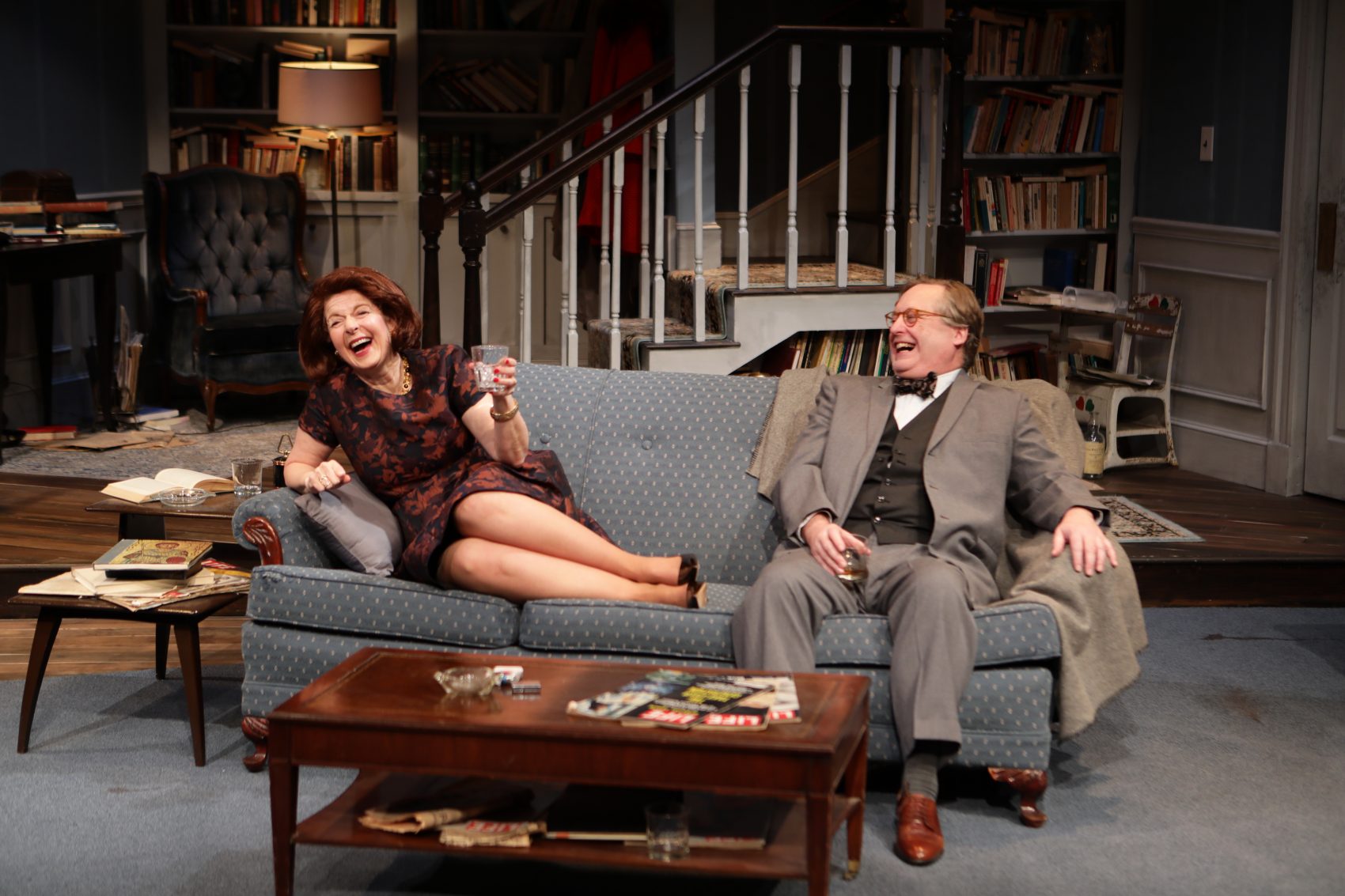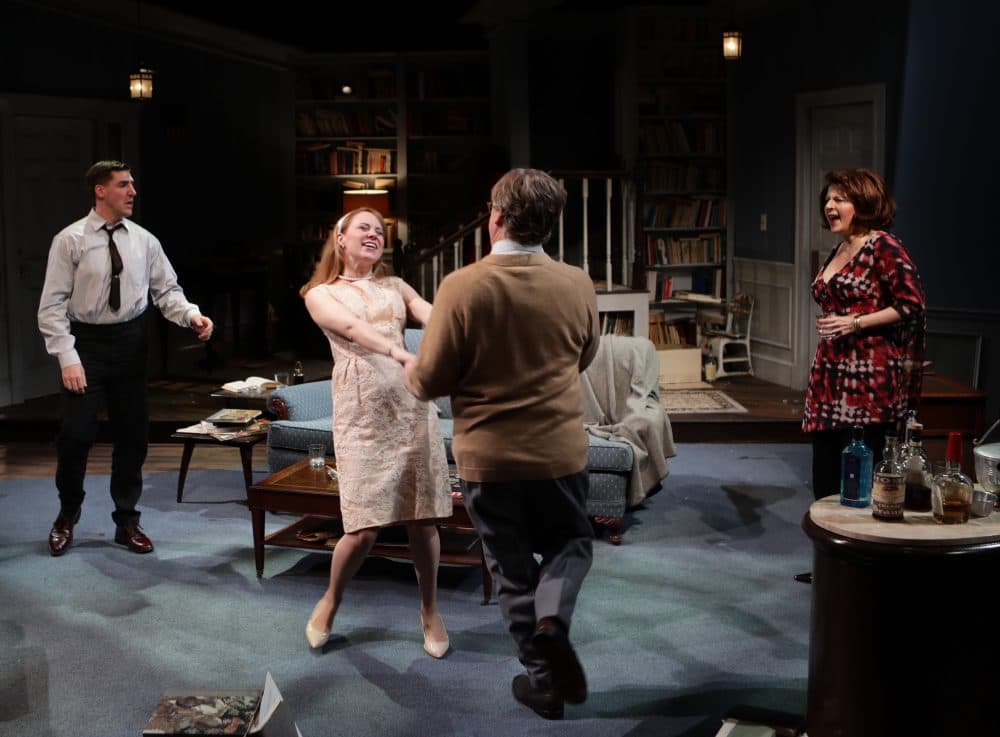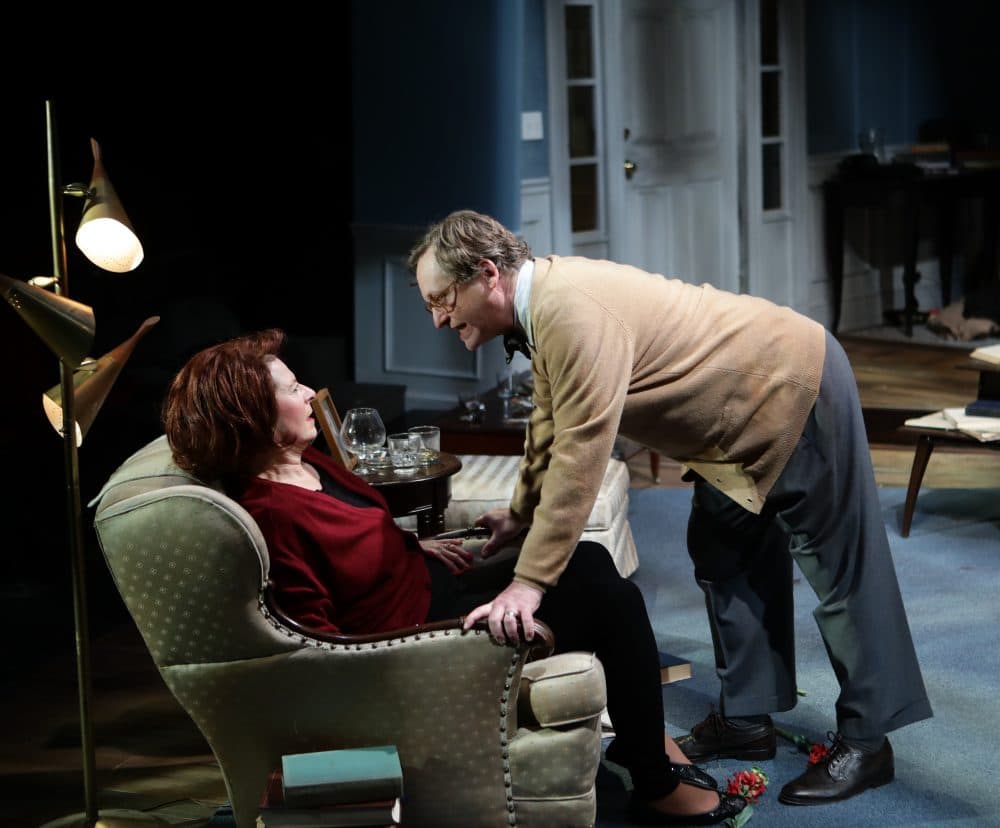Advertisement
The Lyric Stage's Revival Of 'Who's Afraid Of Virginia Woolf?' Is Intimate Yet Spectacular

Edward Albee’s George and Martha are 55 years old now. I don’t know how that lines up with George’s being six years younger than his bawdy, ball-breaking wife, as he constantly reminds her in the admirably arch, emotionally draining 1962 drama "Who’s Afraid of Virginia Woolf?" Maybe age difference evaporates as characters become immortal.
Certainly George and Martha, whose vehicle is being revived by the Lyric Stage Company of Boston (through Feb. 12), have long since been carved into the Mount Rushmore of American theater — doubtless with their stone mouths open since they will never stop their excoriating talking.
At the Lyric, abetted by late-night guests Nick and Honey, Albee’s eviscerating couple squawk and purr and fight through three acts and three hours of linguistic fisticuffs (as the playwright insists they must). And under the insightful direction of Scott Edmiston, with the estimable Paula Plum and Steven Barkhimer doing the sparring, the connubial war is both intimate and spectacular.
For “Virginia Woolf” neophytes (if, indeed, between the numerous revivals and the 1966 film, there are any), George is a history professor at a small New England college, married to the daughter of the university’s president. He seemed an up-and-comer when Martha selected him, but his academic and political trajectories have been disappointing. On this particular evening the pair has returned at 2 a.m. from a faculty party chez Daddy, to be joined by a handsome young faculty newcomer and his unprepossessing wife. The younger couple is to bear witness as George and Martha walk "what’s left of our wits."

What ensues is a booze-fueled marathon of revelatory games dubbed by George “Get the Guests,” “Humiliate the Host,” “Hump the Hostess” and — most ominous of all — “Bringing up Baby.” There is also a debate, danced as if on a razor’s edge, among history, biology and historical inevitability. Not to mention a breast-waggling dance of seduction, danced in part on the couch.
If you are going to do “Who’s Afraid of Virginia Woolf?” you have got to do it accurately — from Martha’s first utterance of “Jesus H. Christ” through the final stripping away of illusions — like so much paint pulled from the wall by buckets and buckets of verbal vitriol. The famously testy author, who died last year at the age of 88, forbade paring of his Tony- and New York Drama Critics’ Circle Award-winning work. Like Eugene O’Neill’s “Long Day’s Journey into Night” (the Joneses with whose epic booze consumption “Virginia Woolf” keeps up), “Who’s Afraid of Virginia Woolf?” is meant to be exhausting.
At the same time, the play's marital “Walpurgisnacht” slips by in a sort of rapturous flood of witty, bristling one-upmanship. Every time I see the play done well, I gird myself for its length, then wonder where the three hours went. Certainly that was true at the Lyric Stage, where the book-strewn early-1960s college-town living room (designed by Janie E. Howland with a subtle twist) exudes just the right weighty, deceptive coziness and the thespian delivery lives up to the script.
Advertisement
If you are not a 20th-century-theater historian, it’s hard to appreciate what a Molotov cocktail the 34-year-old Albee threw at Broadway in this his first full-length work. Though many enthusiasts immediately acknowledged the unwieldy play’s greatness, there were censorship problems (including here in Boston, where the Lord’s name was not to be taken in vain onstage). And in the wake of opening night, at least one New York critic pronounced the profanity-dotted opus “three and a half hours long, four characters wide and a cesspool deep.”
What was perhaps most shocking, though, was that the play was produced on Broadway rather than off, where Albee had had his earlier one-act successes. It has since been revived three times on the Great White Way (mostly recently in 2012), and of course it pops up all over the regional map.
From the beginning, Albee has been coy about the “meaning” of his landmark work while dismissing allegorical theories about it, declaring, for example, that George and Martha’s being named for America’s original First Couple is mere “irony.” And he vehemently denied assertions that the play’s females are really gay men in drag.
Certainly the play, though it echoes “Long Day’s Journey,” repudiates the theme of O’Neill’s “The Iceman Cometh,” in which human beings need their “pipe dreams” to survive. In “Virginia Woolf?” George and Martha’s pipe dream, in the form of their elaborately imagined offspring, must be “exorcised” in order for the pair to go on. And at the Lyric, that ritual is as anguished, subdued and poetical as the warm-up has been scurrilously, bumptiously witty.
For the play to be fully appreciated, I think, the actors must not only be ace but also word perfect. The slightest slip ruins the illusion that phonemes might actually fly from folks’ minds and mouths as perfectly if recklessly formed as they do from George and Martha’s. In the Lyric production, no one stumbles. If a character is momentarily at a loss for words, or if the characters’ words tumble over one another’s, the frustration or feathering is there in the script (though Edmiston orchestrates even more of George and Martha’s incantatory act-three dialogue to overlap than Albee does).

But whereas “Who’s Afraid of Virginia Woolf?” is not to be abridged or removed from its parlor, it is open to interpretation. And in Edmiston’s staging, and Barkhimer’s intense if avuncular performance, we are given a more threatening George than is usual. Plum is a warm, vulnerable if convincingly vulgar and brassy Martha. But Barkhimer’s George, as the poster art for the production suggests, is utterly in her face. He may be a “bog” in the history department, but this bog has whitecaps.
As if to remain competitive, the academician alpha-male Nick of Dan Whelton is similarly muscular if more solicitous. He may be a pawn in this parlor, accustomed as the room is to blood sport, but he’s sufficiently smug and strong to think himself a contender. And Erica Spyres’ Honey, given to nimbly drunken flights of modern dance, is both precious and sad. Whether puzzling over a huge betrayal wrapped in a short story or sprawled on the rug like the rapt if befogged audience she’s meant to be, she draws more focus than you might think possible.
But after all is said and the fun is done, “Who’s Afraid of Virginia Woolf?” belongs to its George and Martha — no matter how desperately they’d like to give it away. In Plum and Barkhimer’s wounded alliance, it is, as the script says, “George and Martha: Sad, sad, sad.” But it is also, in the end, George and Martha well spent.
Correction: An earlier version of this post incorrectly said director Scott Edmiston took some liberties on Edward Albee's script. In fact, Edmiston used Albee's updated 2005 version of the play. We regret the error.
This article was originally published on January 17, 2017.
